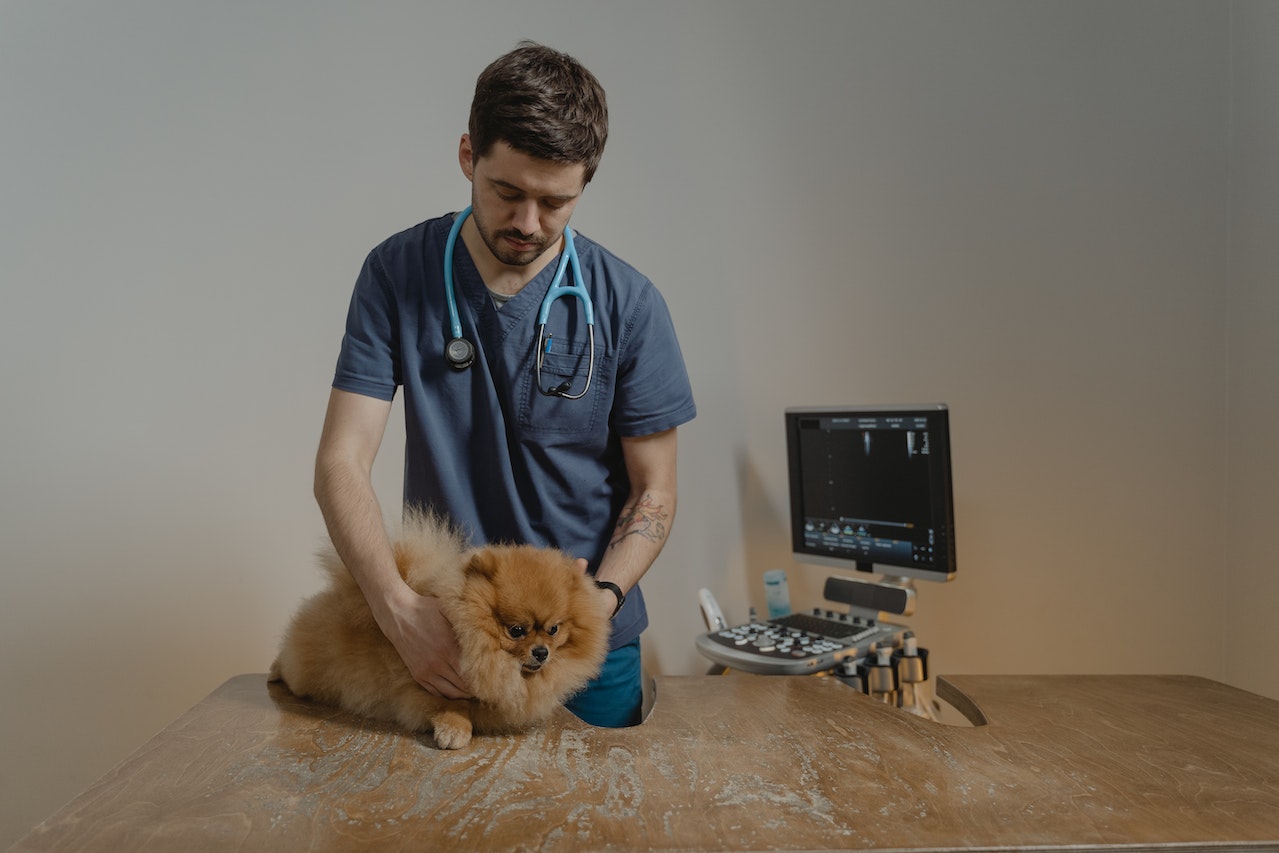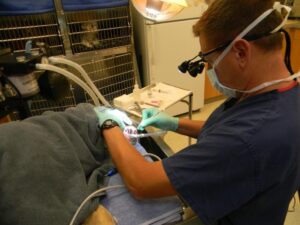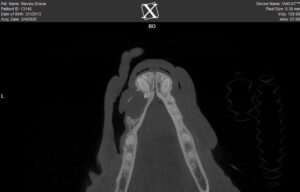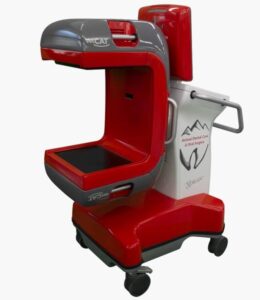
27 Sep What is a COHAT? More than a Pet Teeth Cleaning
Over the past three decades, the veterinary profession has grown by leaps and bounds. This is due to tremendous advances in available technology, but perhaps it is primarily due to growth in the appreciation of the human-animal bond and pet owners seeking comprehensive healthcare for their pets.
Regular Pet Dental Care
An integral part of a comprehensive pet wellness plan is dental care. Dental cleanings at least once a year under anesthesia by trained veterinary professionals are the most important part of pet dental care, particularly in the absence of daily at-home tooth brushing by a pet owner.
These regular dental cleanings have been given numerous names. The simple title, “dental” or “dental prophy,” have classically represented an anesthetized dental cleaning for a pet, but they really do not do justice to what the procedure actually accomplishes.
This has caused members of the American Veterinary Dental College to gravitate towards procedure names and acronyms that more accurately describe for a pet owner what their pet is receiving.
I personally do not know who developed the term, but I have adopted the acronym C.O.H.A.T. (Comprehensive Oral Health Assessment and Treatment) for our clinic’s dental cleaning procedures in Colorado Springs.
We have realized the need to get away from simply calling our procedures a “pet dental” since it does not convey to pet owners in a meaningful way what we actually do for their pets.
Prophylactic Cleanings
Humans frequently are advised by their dentists to have dental cleanings performed every 6 months and often refer to these procedures as “dental prophys”—the phrase prophylaxis means prevention.
Humans who have their teeth professionally cleaned every 6 months and who practice good daily oral hygiene are most likely having true “prophy” procedures since they are preventing dental disease. Truth be told, only a small amount of veterinary dental cleaning procedures are actually prophylactic or preventative procedures, since the veterinarian and their staff are most often treating active dental disease.
Sadly, this is due to the very small percentage of pets who receive daily dental care at home in the form of brushing.
So, What is a COHAT?
Now that we have covered the foundations of good oral health care for pets, what should actually take place in a C.O.H.A.T.?
I like to look at it as a 12-step procedure.
Step 1 – Your Pet’s History
Involves the veterinarian and their staff taking a complete history from the pet owner and performing a full physical examination. Questions we ask include:
- What is the pet owner’s present concern?
- When did the problem start?
- How has it progressed?
- What physical and behavioral changes have they noticed at home?
- Is their pet eating and drinking normally?
- Is there any vomiting, diarrhea, coughing, sneezing, or other concerning problems taking place?
- What is the pet’s previous dental cleaning history and how have they done with anesthetic procedures?
- Is the owner able to perform any at-home dental care?
- What is the pet’s previous medical history, and does it have any ongoing problems outside of dental concerns?
- Is the pet on any medications and has it shown any history of allergies?
You get the idea of the number of detailed questions that need to be asked to obtain an accurate history of a pet. The veterinarian then performs a complete examination by evaluating the eyes, ears, nose and throat. The heart and lungs are auscultated, and the abdomen is palpated. The peripheral lymph nodes are evaluated, and the skin and coat are checked for abnormalities. The overall constitution and body score of the patient is noted and recorded.
Step 2 – Awake Oral Exam
The veterinarian will note and grade the severity of dental calculus and gingivitis. The presence of fractured, worn or loose teeth will be recorded in addition to abnormal swellings or masses within the oral cavity. I
t should be noted that this is just the first part of the oral examination. Pets will not allow a complete dental charting of their mouths while awake. I can safely estimate that more than half of the oral pathology diagnosed by veterinarians is done with their patients under anesthesia. Dogs and cats will simply not sit with their mouths open to allow a comprehensive examination, especially if they are dealing with painful dental issues.
Step 3 – Anesthesia
Involves safely placing the patient under anesthesia and starting the cleaning process. The first part of the dental cleaning will be supragingival calculus removal. This is the removal of calculus above the gingival margin and is accomplished with ultrasonic dental scaling devices that are made for veterinary patients. Pets with more significant buildup may require the use of a hand instrumentation before ultrasonic devices are used.

Figure 1. Dr. Erich Rachwitz from thevetdentists.com team performing a complete oral exam on an anesthetized patient.
Step 4 – Subgingival Scaling
This step involves removing plaque and calculus below the gingival margin with ultrasonic devices and hand curettes. This is the most important part of the dental cleaning since the tissue below the gumline, the gingival sulcus, is where the inflammatory process of gingivitis begins.
Gingivitis is the first stage of periodontal disease. Left untreated it will allow plaque bacteria and inflammatory products to penetrate gingival defenses and enter the bloodstream. Initially, the body’s immune system is able to remove these bacteria, but over time and without treatment, they will have numerous deleterious impacts on other organ systems, such as the heart, liver and kidneys. Diabetes, in particular, is greatly complicated by the presence of periodontal disease.
Step 5 – Teeth Polishing
Next, the teeth are polished with a fluoride or flour pumice paste. This is not with the goal of making the teeth pearly white, but to make the cleaned surface smooth and less plaque retentive.
The cleaning and scaling process of the previous steps leaves a clean, but roughened, surface. Bacteria and plaque love an irregular surface to adhere to. Thorough polishing of the tooth will make it less likely for plaque to quickly reform.
Step 6 – Irrigation
Complete irrigation, or lavage, of the mouth is performed. The cleaning and polishing processes cause a large amount of calculus and polishing paste debris to be liberated in the mouth that must be removed. This can be accomplished with flushing devices using water, saline or antiseptics followed by the mouth being thoroughly dried.
Step 7 – Applying a Sealant
At my clinic is where a barrier sealant called Oravet is applied. This wax barrier sealant forms a bond with the tooth surface and safely prevents plaque from reforming for up to two weeks. A homecare kit is available for owners to apply weekly at home.
Step 8 – Charting
Involves the completion of the oral examination and thorough oral charting of the entire dentition. This is a team effort where the veterinarian probes and examines each individual tooth and their findings are recorded by their staff member.
Step 9 – Dental Radiographs
Digital full-mouth dental radiographs are completed in most dental practices. It simply is not possible to provide quality veterinary dental care without dental radiographs. The oral examination will typically only reveal visible abnormalities above the gumline. It does not give the veterinarian information about the underlying roots and surrounding bone.
Full mouth radiographs have been documented to find 42% more abnormalities in cats and 28% more in dogs when compared to taking radiographs of only visible abnormalities above the gumline.
A new trend in specialty dental practices is the advent of cone beam computed tomography (CBCT). This amazing new diagnostic imaging device reduces anesthesia time compared to dental radiographs and provides the veterinarian with more detailed 3-dimensional images.
While not completely replacing dental radiographs, CBCT will greatly reduce their use over the coming years. I’m proud to say that Animal Dental Care and Oral Surgery in Colorado Springs was the first veterinary facility in Colorado to have a cone beam CT in its practice.
All of the board-certified veterinary dentists that are part of thevetdentists.com team either have a CBCT unit or are in the process of acquiring one.
(It should be noted that many veterinary clinics will perform their imaging prior to the cleaning process. There are advantages to each method. My clinic has recently started performing our imaging prior to the cleaning the process)

Figure 2. A cone beam computed tomography image of a dog’s mandible. The mandible has a large dentigerous cyst secondary to an impacted premolar.

Figure 3. The cone beam CT unit used at Animal Dental Care and Oral Surgery in Colorado Springs.
Step 10 – Review of Treatment Plan
Completion of the treatment plan and its presentation to the pet owner. The veterinarian has had the opportunity to evaluate their dental radiograph (or CBCT) images and combine these findings with the oral examination.
Once again, since the majority of COHATs are not true preventative procedures, but involve active treatment, the treatment plan most often involves more than just the dental cleaning. The veterinarian calls the pet owner to go over their findings followed by a staff member reviewing the cost of the treatment plan.
No procedures are ever performed without the pet owner’s knowledge and permission.
Step 11 – Patient Discharge
Occurs after the anesthetized portion of the cleaning and will cover the discharge of the patient with all aftercare instructions provided to the owner. Many clinics will include digital pictures of the pet’s teeth and dental radiograph images in their discharges. This is also where homecare options are presented to the owner.
No other homecare product can take the place of daily tooth brushing. While challenging for many pet owners, the veterinary team can help them with how to perform this technique. Many pets are simply not willing to allow tooth brushing, especially if they had previously painful oral health issues that have now been treated.
Step 12 – Schedule Followup
The final COHAT step plans for the future. If a tooth was surgically extracted, the clinic will likely want to recheck the site in 1-2 weeks. If the owner is unable to brush their pet’s teeth, many clinics will now advise a COHAT every 6 months.
We should ask ourselves what our mouths would look (and smell) like if we did not brush our teeth daily and have them professionally cleaned at least annually. If the owner is able to perform meaningful daily at-home dental care, annual COHATs are often sufficient.
Board-Certified Vet Dentists in Colorado Springs
Each veterinary clinic will have its own “steps” and order to a COHAT procedure to hopefully provide you and your pet with a truly comprehensive procedure. The doctors and staff at Animal Dental Care and Oral Surgery in Colorado Springs strive to provide our clients with the best in veterinary dental care for their much-loved pets.
If you live in Colorado, please call (719)536-9949 if you have questions about your pet possibly needing a COHAT procedure. If you are outside our state, please feel free to reach out to one of the other board-certified veterinary dentists around the country that are part of thevetdentists.com team.
Photo by Tima Miroshnichenko

